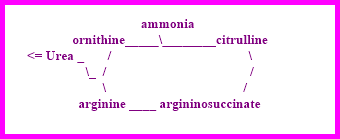Ammonia
& the
Urea Cycle
![]()
Ammonia is a left over molecule in the breakdown of proteins. Amino acids have no storage mechanism. If extra amino acids are present, they get broken into fragments by any of several offshoots from the citric acid cycle.
H-N-H amino
|
H-C-/\/\/\/\ <= twenty one choices of things go here
|
C=O acid
|
OH
This is an amino acid structure in which the repeating unit is [N-C-C] such that a protein is a long chain of [N-C-C]-[N-C-C]-[N-C-C]-[N-C-C]-[N-C-C]- . . .
The central carbon carries a side piece which varies in property from being an acid, a base, an oil, a water soluble thingy, a straight stiffening piece, an amino acid bending piece and so on. The side pieces allow shape and surface property choices such that balled up, they can form all sorts of molecular machines.
To break down amino acids the side pieces need to be dealt with, thus the several places in the citrate cycle to handle the differing hunks. But the nitrogen part, the
H-N-H
|
part, called the amino portion, when snipped off to leave the two carbon
fragment free to join the citrate cycle, is known as ammonia.
Ammonia also comes from DNA metabolism as well. Some of the ammonia is used in synthesis of glutamine (a neurotransmitter among other jobs) and other substances. But it can not always be used and needs to be disposed of as it is toxic just floating around in excess.
In the liver ammonia can be added to ornithine to make a molecule called citrulline:
 |
In the "urea cycle", citrulline morphs its way back to ornithine again in the process losing the ammonia as urea, a soluble substance which can be disposed of safely.
In the brain, ammonia joins with alpha ketoglutarate to make glutamate. This picks up another ammonia to make glutamine. A few more chemical flips and ammonia is pulled off to get back to alpha ketoglutarate which completes yet another cycle (with two ammonias in and one out). But cycles don't really go round. The components get pulled off into other pathways. As with a traffic circle, in theory any car can go round and round, but actually it comes in at one place and exits at another. The cycles are better named crossroads.
Ammonia, in excess, can cause coma by way of poisoning pyruvate from forming citrate and subsequent inability to make aspartate. It amplifies GABA (another neurotransmitter). It poisons the energy creating pathways and a variety of other protein actions. Glutamine is also processed abnormally with domino effects on serotonin. It goes on... suffice it to say that ammonia is toxic in excess.
The point to all this is that defects in the urea cycle can result in ammonia build up spilling into the blood and producing coma, making the brain swell and doing direct damage to an assortment of tissues.
For just about every step in the cycles above (and some ommitted) there are named diseases which produce ammonia and brain-muscle syndromes. Some seemingly unrelated defects in metabolism, from afar, can disturb the urea cycle and thus indirectly produce these syndromes.
The recognition of one specific out of these many many possible defects is one thing, getting around faulty enzymes is another. Interestingly, the pediatricians and neurologists have been amazingly adept at tweaking the biochemistry in a number of these syndromes such that we see full grown children with metabolic diseases that even a short time ago could not possibly survive.
It's a tough road, though.